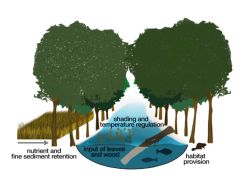Aims of OSCAR

Woody riparian buffers along rivers provide multiple ecosystem functions and related services: nutrient and fine sediment retention, shading and regulation of water temperature, provision of organic material as food source, habitat provision (terrestrial and aquatic), migration corridor, cultural services (e.g. recreation).
However, there is limited knowledge on the overall benefits of these ecosystem services and especially on how these effects depend on the spatial arrangement and add up at the river network and catchment scale, which limits the strategic and targeted implementation of woody buffers.
The three main objectives of OSCAR are achieved by:
- summarize the knowledge on the local effects of woody buffers on ecosystem functions and biodiversity
- complement the knowledge rules with studies on the large-scale river network and catchment effects
- develop and test a modelling approach to assess woody riparian buffer effects at larger river network and catchment scales
- investigate different scenarios in case-study catchments to identify woody buffer configurations with high overall effects
- guide the use of woody buffers in river management at different levels:
- provide simple knowledge rules on the effect of different woody buffer configurations for practical local use
- synthesize them into a GIS tool for river management to assess the effect of woody buffers at larger river network and catchment scales
- transfer results of scenario runs into policy recommendations at national and EU levels, especially for the implementation of the WFD and establishment of funding schemes under the Common Agricultural Policy (CAP)
Please don´t hesitate to contact us for more information